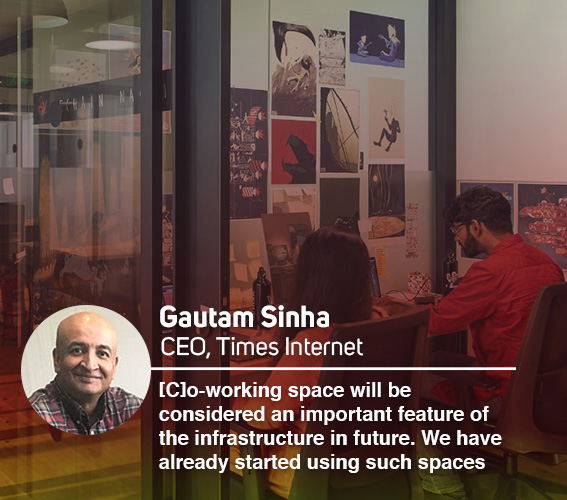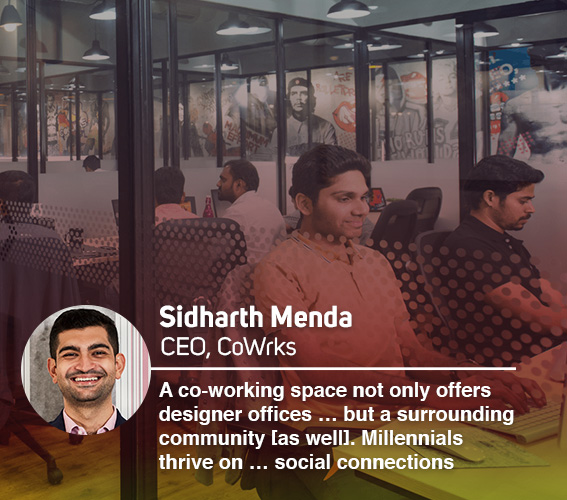When Brad Neuberg introduced the world to the concept of co-working spaces, he may not have had the slightest inkling about the success it would see a decade later. Today, the idea has metamorphosed into a full-blown industry. The demand for shared office spaces is rising due to strong economic fundamentals, constantly improving business environment, improved infrastructure and increased investor activity.
India is the third largest start-up hub in the world, with three or four start-ups emerging every day with a total employee base count of nearly a million, according to a study by JLL and the Confederation of Indian Industries (CII). In addition, the freelance worker base of India is the second largest in the world. Taken together, this has led to a potential demand of four million seats in co-working spaces or otherwise. With start-ups, SMEs and even corporates lunging for co-working spaces, leasing activity by co-working and business centre operators more than tripled in 2016 as compared to 2014 to about 0.7 million square feet, states the “India Major Report: The Art of Co-working”, a report by CBRE, which was published in 2017.
However, it is not just the demand for office environment that is driving the growth of co-working spaces. There is something else at work here too. Sumit Lakhani, chief marketing officer at Awfis, which provides co-working office space for rent, says, “Shared spaces are all about their spirit of collaboration and high energy. Business models are moving towards solving the demand-supply gap. While most of the real-estate developers in the country are focused on solving space requirements of large companies, new-age co-working companies are striking model terms with landlords, catering to significant latent demand in smaller, mid-sized and yet stable companies.”

There are almost 350 shared office operators in India. According to estimates by JLL India and the CII, business centres across the country are set to double by 2020. At the end of the 2018, the co-working segment is expected to receive $400 million in investments.
When it comes to commercial space leasing, India is one of the largest markets in the world; at least 40 to 45 million square feet of absorption is being held in office space every year, according to industry experts. Office space leasing touched a record high of 11 million square feet in the March quarter of 2017.
Also read: Co-working space stock crosses 8 million sq ft in top 8 cities: report
Co-working spaces are further seeing growth in office leasing with companies realising the importance of these spaces. The reasons are galore: cost effectiveness, better engagement with design, heightened connectivity with businesses, producing opportunities of innovation, etc. The rising acceptance of “remote” working and an increased preference towards flexible leasing terms will be factors that drive demand for co-working spaces in the times to come. “Co-working operators help start-ups avoid hefty capex, which is relevant at the moment. These are companies that do not necessarily need a front office identity, and therefore it is needless to spend on costs that arise from expenditure such as common area maintenance and overhead costs,” says Shobhit Agarwal, managing director, capital markets, at JLL India, in the company’s report.
When big guys share
While start-ups love the concept of a larger workplace, global players too are showing great interest in co-working spaces to cut huge operational cost. The CBRE report envisages cost saving of at least 10 to 25 per cent by leasing co-working space as compared to conventional leasing in larger cities of Delhi, Gurgaon, Bangalore, Mumbai and Pune.
Even as office rentals continue to inch up across India, the total space leased by co-working operators in Tier I and Tier II cities is expected to be almost six to 10 million square feet by 2020.
It has been observed that large corporate firms which are opting for co-working spaces look for hot desks as well as fully furnished offices. They specifically require innovative models within shared spaces in cities where they do not have any existing offices, preferably for a team size of 10 to 15 employees. Gautam Sinha, chief executive officer of Times Internet Ltd, says, “The way workplaces are changing with the implementation of technology and Internet of Things, co-working space will be considered an important feature of the infrastructure in future. We have already started using such spaces.”
Awfis’ Lakhani knows that there is a good opportunity in preparing to attract larger players too. He adds, “As more corporates look forward to expanding or consolidating their operations through shared workspaces, leasing activity will continue to rise. Rental growth is expected to be stronger in the peripheral and sub-urban micro markets across cities like Mumbai, Delhi, Hyderabad, Pune, Bangalore and others.”

Companies like Vodafone, Mercedes Benz, Hitachi, ShareKhan, Zomato, Practo, etc. operate from various Awfis centres. The company witnessed the fastest growth within three years where larger companies and SMEs were its main customers. “Lately, in addition to start-ups, SMEs and large-scale enterprises have also begun to opt for shared workspaces. With an SME that has about 100 people and a revenue in multi-crore, there are less chances of uncertainty. Large companies come with the biggest chunk of stability,” Lakhani adds.
Millennial culture
India is the youngest start-up nation in the world, where 72 per cent of the founders are less than 35 years, according to the report by JLL and the CII. Previously, employees were expected to put in eight to nine hours a day in cubicles at workplaces and hierarchy was highly regarded. Today advancements in technology have made it possible to work from anywhere at any time and millennials are at the centre stage of this trend. Industry experts says that youngsters are driving the Indian workforce and their ways of working are entirely different from past generations; thus, there is a growing need for building communities where co-working space shapes the future of work.
Sidharth Menda, CEO of CoWrks, which lists Alibaba.com, Standard Chartered Bank, Ernst & Young among its clients, is of the opinion that young employees demand flexibility and freedom. Accomplishing the task is more important than coming to office.

Menda says that for the past few years there has been a quantum shift in the workforce which is driven by the millennial generation, where it caters to 50 per cent of the workforce. “SMEs and enterprises need to attract the millennial workforce for the best talent. But the biggest challenge is to retain them; hence companies are opting for co-working space as the millennials work differently from past generations,” he says, adding that according to large companies, it’s not easy to retain the younger talent in their traditionally designed workspace as they find it boring. “Co-working space not only offers designer offices that appeal to them but the surrounding community. Millennials thrive on their social connections and co-working gives them the right atmosphere,” says Menda.
While large companies can always afford their own office spaces, the appeal lies in mingling with other people and thinking out of the box; in other words, they like the start-up culture rubbing off on them.
Menda adds that in their 10,000-member base, more than 50 per cent belong to large enterprises. Most of them have their own offices but operate from co-working spaces as they have strategised their working with hybrid or dual approach model.
Tech as support and demand driver
Technology plays a major role in enhancing the co-working trend. According to Citrix’s “Workplace of the Future” report, about 89 per cent of global organisations will offer mobile work styles by 2020, enabled by mobile working technology. As the world shifts from “workplaces” to “places to work”, information and technology, human resources and CRE functions must work together to create new policies and solutions that respond to this change. Improved technology has enabled easy access to Wi-Fi and other IT solutions in remote areas as well and thus resulted into an easier working environment.
Sinha adds, “If I fast-forward to 2025, I can see a shift happening towards the gig economy, which means people will work from anywhere and at any time, irrespective of whether they are working part-time or full-time. This is where co-working space comes into the picture.” He adds, “Co-working space is a great example of shared economy. It is the same model Uber and Airbnb have followed. Today even enterprises are opting for it and they are letting even half of their workforce in the co-working space.”
Technology is an important feature in a co-working environment. A vast majority of the clients of co-working space operators are in the service sector, particularly tech development. Even when larger players from traditional economy rent co-working spaces, they often use them for servicing their clients. With this profile, a tech infrastructure becomes the backbone of this emerging sector. Lakhani says, “The reasons for the changing scenario are increasing real estate costs, overhead expenses and need for a vibrant environment, among others. Tech remains the biggest demand driver, as tech corporates have taken up 25 per cent of office spaces in India while the IT industry is said to account for about 58 per cent of total office demand in India. As predicted by property consultants, the shared workspace operators will lease eight to nine million square feet of office space by 2020.”
People have started seeing value in co-working spaces, says Menda of CoWrks. “Last year, office leasing in co-working space was one to two per cent. It is expected to rise in the next five years and accounts for 30 per cent of the office land absorbed.”
A positive influence of this new trend is that unorganised sector users — that is start-ups, freelancers and SMEs — are becoming organised. Also, time spent at workspaces is resulting in tighter bonds, resulting in better collaboration and productivity. This is leading to further expansion of the co-working space market. The segment is also adapting and expanding its service horizon according to the trends and people spending time at workplaces. “It is just not about providing private offices, workstations, lounge areas or meeting rooms. Co-working spaces are also inculcating different amenities into the ecosystem according to the time people spend at workplaces. In our new Bengaluru CoWrks centre, we have infinity pool, rock climbing walls, golf course, games court and wellness amenities,” says Menda.
“The future of this industry will redefine the term ‘co-working’. The trend is moving towards creating beautiful, well-designed and functional spaces that encourage collaboration and create a sense of community. There will be a paradigm shift in the way companies operate in future and some of the best innovations will be an outcome of such true community collaboration,” says Juggy Marwaha, India lead at WeWork, a co-working space provider, in “India Major Report: The Art of Co-working”and this sums up the character of this sector in India.
Also read: Impersonal banking! Yes, that’s how banks are serving you quicker now











